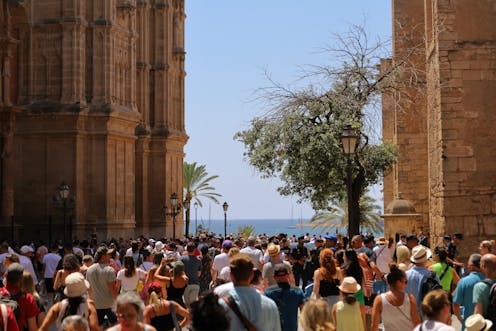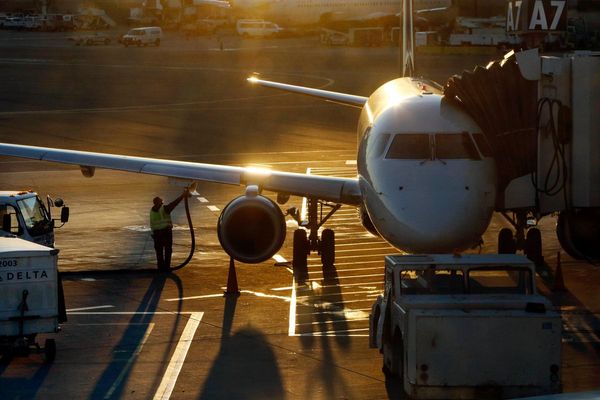
One of the most frequent comments among the population residing in the Spanish Balearic Archipelago – a renowned tourist destination for Europeans – used to be: “Tourists consume a lot of water.” But what was this statement based on or supported by?
Many questions regarding the relationship between tourism and water don’t have easy answers. Tourism clearly consumes water – visitors arrive during the warmest time of the year, favour water activities, bathe, shower, and so on. No matter how you look at it, water is linked to tourism and tourism cannot thrive without water.
A complicating factor is that tourism is highest just when there is less water available, and the islands generally have limitations in terms of space and renewable resources. That is, many people are packed together in a small space for a limited time and at a moment of water stress.
Missing information
If the importance of water for tourism is self-evident, why haven’t we studied all the related data? Often it’s because the places that tourists stay get their water from city supply networks – just like residents, businesses and industry. All these activities are lumped together as the city’s consumption, meaning that there’s little information on water use by activity.
In the scientific literature, there are examples of hotels around the world where the water company, establishment, or chain has provided such data. But if a citizen consults the hydrological plan of Spain’s tourist areas – for example, the Canary Islands, Balearic Islands, Segura and Júcar – they will not find data on water consumption specifically from tourism.
The pandemic: a unique opportunity
In 2020, the Covid-19 pandemic hit our lives hard and it affected one of the main economic sectors in the Balearic Islands: tourism. For the first time in history, we had a lockdown that cut off the islands. From the middle of March to the end of June, the ban on the entry of people by sea and air brought about the situation we call “zero tourism”. Mobility and general activities were clearly reduced to the essential aspects of life. Water consumption was exclusively by island residents.
This anomaly allowed us to think about a possible answer to the question that we had always asked ourselves in the research group: How much water does tourism really use? We were able to obtain water consumption data during the months of April, May, and June 2020 at the municipal level and compare that with the same months of the previous year, when there was tourism.
The task was not easy because the collaboration of the municipalities was needed and the sample had to be representative of the four islands and of the different types of tourism in the municipalities. Cooperative efforts with the Studies and Planning Service of the Directorate-General of Water Resources of the Balearic Government were decisive in obtaining data from nine municipalities.
The most touristic municipalities are the most affected
Data analysis shows that during the lockdown – the period of zero tourism – there was a 24% decrease in water consumption in the Balearic Islands). In other words, tourism consumes one out of every four litres in the archipelago. Translated into volume, that would be about 33 million cubic metres – a figure similar to that used by agricultural irrigation with groundwater.
In Mallorca there are two reservoirs that, when full, store a total of 11 million cubic metres. Each year, tourism in the Balearic Islands would consume three times the amount that those two reservoirs hold when completely full.
In science, averages are sometimes not the best reflection of reality – especially in an area as diverse as the Balearic Islands. When data is analysed at a municipal level, the values obtained take on another meaning.
Water consumption varies among municipalities depending on their degree of specialisation in tourism. The most touristic municipalities saw their water consumption drop by 58% during the pandemic, those with medium touristic activity saw a reduction of 40%, and those with low activity saw a reduction of 14%.
As an overall value, tourism in the Balearic Islands consumes a percentage of water that may seem low to us. However, when looking at this analysis by municipalities and according to the degree and type of tourism, we realise that water consumption is very significant in certain municipalities and that we cannot be sure how those municipalities will fare the future pressures of tourism on water resources.
We are all responsible
In large municipalities such as Palma or Eivissa, where the majority of residents live, water consumption is high. Thus, daily pressure in the Balearic Islands in terms of the number of people is also an element to take into account in the management of the water.
The study confirms what was previously an impression but for which we had no data: tourism consumes water and, in some places, it does so excessively. Our research also demystifies the idea that tourism is solely responsible for this consumption, and it shows that the resident population also places significant pressure on water resources in the Balearic Islands.
Current and future water management involves recognising and evaluating this pressure from tourists and residents based on municipality type. This research is the step forward that was needed in terms of accounting. Society will appreciate this work and it will help us to face a serious debate on water with real data and not fictitious or made-up notions.
Bartolomé Deya Tortella receives funding from the Spanish Government through various research projects.
Pablo Rodríguez Lozano receives funding from the Ministry of Science and Innovation through the Juan de la Cierva - Incorporation programme (IJC2019-041601-I).
Celso García, Dolores Tirado Bennasar, Enrique Morán Tejeda, and Jorge Lorenzo Lacruz do not work for, consult, own shares in or receive funding from any company or organisation that would benefit from this article, and have disclosed no relevant affiliations beyond their academic appointment.
This article was originally published on The Conversation. Read the original article.







